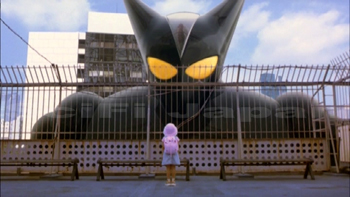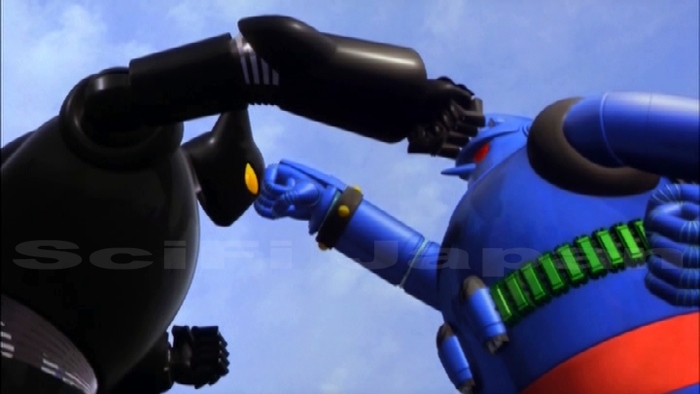Author: Aaron Cooper Source: Geneon Video Special Thanks to Bob Johnson
It looks like Japan is on the same bandwagon as the United States in remaking, re-imagining and re-tooling older properties for the next generation. Unfortunately, with this comes the same pitfalls and lack of imagination Hollywood suffers from in this era of remakes if not done correctly. TETSUJIN-28, known as Gigantor in the States, is no exception. The 2005 production of TETSUJIN-28 has a promising premise. A fatherless boy, talented yet misunderstood and bullied by his peers, comes to find out his father had been working on a top-secret giant robot project before he was killed. When a former colleague of Dad’s starts attacking Tokyo with his own giant robot known as the Black Ox, it’s up to young Shotaro to grasp the radio control of destiny and command Tetsujin-28 to stand up for right against wrong! How does one go wrong with a live action giant robot film? One would think this is money in the bank, yet let us count the ways a production of this nature spirals helplessly out of control. First of all, the script is as standard and cookie-cutter as a film gets. It’s nothing that hasn’t been seen in at least two dozen films or TV shows, many of which can be told in a 30-minute timeslot while this film drags along for nearly two-hours. In fact, the TV series MIKAZUKI told a very similar story in a much more imaginative way, and several years before this release. Though the story idea for TETSUJIN-28 goes back to the manga of the 1950’s and the animated series of the 1960’s, nothing is done to flesh out the story for a feature-length film, and it suffers for it. The story is so generic, any giant robot or monster could have been inserted into it and it would have come out the same. It has a very recycled feeling to the script, even though characters and cameos are inserted into the film for fans of the original telling.
The cast does not help the production in any way. You want to like Sosuke Ikematsu as Shotaro, yet he’s so whiney and unbearable, one finds themselves cheering when he’s getting bullied and that’s not the point of the film! Shotaro’s mother, the cops, the scientists, even the villains are all one-note characters at best and caricatures at worst. It is as if there is not one stand-out leading person. Rather an entire cast of supporting characters attempt to carry the film. An ensemble cast is fine for many productions, yet there needs to be some that stand out for the viewers so they may have someone to like, dislike or relate to. This film has none. After all this, one hopes for some massive payoff in the giant robot battle sequences. Yet again, the viewer is let down. Though there is a very nice destruction sequence of Tokyo Tower by Black Ox early in the film, the overall giant robot special effects are limited to just a few short minutes in about three spots in the film. In fact at one point, more run time, choreography and footage is spent on a bullying scene then there is giant robots battling it out. How wrong is that? The few scenes that do exist of giant robots are clunky and awkward using sub-par CGI work. The punching between Tetsujin-28 and Black Ox is clumsy, making it slow and monotonous to watch. The story even attempts a predictable metaphysical turn, implying that Tetsujin-28 might be controlled by the spirit of the dead father, and Black Ox may contain the essence of the villain’s late son, thus making for an obvious climax and film finale.
The biggest crime the feature commits though is that it’s just plain dull, featuring none of the peaks and valleys in action and drama a film of this nature should have. There is no real character development, no splashy action, any heartfelt drama, and the barest of substance. If this film had been released as a matsuri matinee film, trimmed down to about 45 minutes, it may be forgivable. As the feature-length production with all the bells and whistles it boasted, it’s definitely not “stronger than strong”. It`s mediocre at best and, based on the negative reviews TETSUJIN-28 also received following its US premiere at the 2005 New York Asian Film Festival, very few people will be standing in any lines to pick up the Region 1 DVD this July 4.




